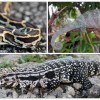Abstract
Captures and postmortem examinations, or necropsies, of invasive or nonnative animals may provide insight into the ecological impact of these invaders. Researchers should be able to perform necropsies when an opportunity arises to examine nonnative species for study. While the techniques described serve as a guide to necropsy of all reptiles, we focus on exotic species found in south Florida. South Florida provides prime habitat for invasive reptiles such as Argentine black and white tegu and Burmese python, and these species are used to describe our techniques. This 26-page fact sheet was written by Seth C. Farris, Michiko A. Squires, Frank Ridgley, Emma Lavergne, Mitchell Serota, and Frank J. Mazzotti, and published by the UF Department of Wildlife Ecology and Conservation, September 2013.
http://edis.ifas.ufl.edu/uw382
References
American Veterinary Medical Association. (2007, June). "AVMA Guidelines on Euthanasia: Formerly Report of the AVMA Panel on Euthanasia." <https://www.avma.org/KB/Policies/Documents/euthanasia.pdf>
de Buffrénil, V., Castanet, J. (2000). "Age Estimation by Skeletochronology in the Nile Monitor (Varanus niloticus), a Highly Exploited Species." Journal of Herpetology 34 (3): 414-424. https://doi.org/10.2307/1565365
Cagle, F. R. (1946). The growth of the slider turtle, Pseudemys scripta elegans. American Midland Naturalist 36:685-729. https://doi.org/10.2307/2421465
Canadian Council on Animal Care. (2004). "CCAC species-specific recommendations on: Amphibians and Reptiles." <http://www.ccac.ca/Documents/Standards/Guidelines/Add_PDFs/Wildlife_Amphibians_Reptiles.pdf>
Close B., Banister, K., Baumans, V., Bernoth, E., Bromage, N. , Bunyan, J., Erhardt, W., Flecknell, P., Gregory, N., Hackbarth, H., Morton, D., and Warwick, C. (1997). "Recommendations for euthanasia of experimental animals: Part 2," Laboratory Animals 31: 1-32 https://doi.org/10.1258/002367797780600297
Conroy, C.J., Papenfuss, T., Parker, J., Hahn, N. E. (2009). "Use of Tricaine Methanesulfonate (MS222) for Euthanasia of Reptiles," Journal of the American Association of Laboratory Animal Science 48 (1): 28-32
Halliday, T. R. and Verrell, P. A.. (1988). "Body Size and Age in Amphibians and Reptiles." Journal of Herpetology 22 (3): 253-265. https://doi.org/10.2307/1564148
Hobson, K. A., Lisle Gibbs, H., and Gloutney, M. L. (1997). "Preservation of blood and tissue samples for stablecarbon and stable-nitrogen isotope analysis." Can. J. Zool. 75: 1720-1723. https://doi.org/10.1139/z97-799
Jacobson, E. R. (2007). Infectious Diseases and Pathology of Reptiles: Color Atlas and Text. Boca Raton: CRC Press. 219-235 and 304-305. https://doi.org/10.1201/9781420004038
Jacobson, E. R. (1978). "Reptile Necropsy Protocol." The Journal of Zoo Animal Medicine Vol. 9, No. 1: pp. 7-13 https://doi.org/10.2307/20460184
Jacobson, E. R. (2012). University of Florida. In discussion with the authors, March 2012.
United States Department of Agriculture. "National Veterinary Services Laboratories Guidelines for Necropsy." 10 Sept. 2012. Retrieved from <http://www.aphis.usda.gov/animal_health/lab_info_services/downloads/NecropsyGuideline.pdf>
Rabinowitz, A., Hart, J., White, L. (2000). Information from dead animals and their curation. Pp. 191-201 in: Conservation research in the African rain forests: a technical handbook. White, L., Edwards, A. (eds). Wildlife Conservation Society, New York. ISBN: 0-9632064-4-3.
Raverty, S. A., and Gaydos, J. K. Killer Whale Necropsy and Disease Protocol. Retrieved from <http://www.seadocsociety.org/files/pdfs/orcanecropsyprotocol.pdf>
Senning, W. C. (1940), A study of age determination and growth of Necturus maculosus based on the parasphenoid bone. Am. J. Anat., 66: 483-495. https://doi.org/10.1002/aja.1000660307
Seutin, G., White, B. N. and Boag, P. T. (1991). "Preservation of avian blood and tissue samples for DNA analysis." Can. J. Zool. 69: 82-90. https://doi.org/10.1139/z91-013
Stahl, S. (1996, February-March). "Necropsies: Post-Mortem Exams Help the Living." League of Florida Herp Societies. Retrieved from <http://www.anapsid.org/necropsy.html>
Vigil, S. Southeastern Cooperative Wildlife Disease Study, University of Georgia College of Veterinary Medicine. In discussion with the author, December 21, 2012.
Unless otherwise specified, articles published in the EDIS journal after January 1, 2024 are licensed under a Creative Commons Attribution-NonCommercial-NoDerivs 4.0 International (CC BY-NC-ND 4.0) license.

